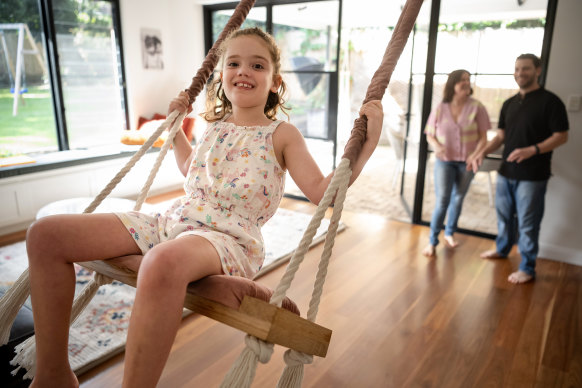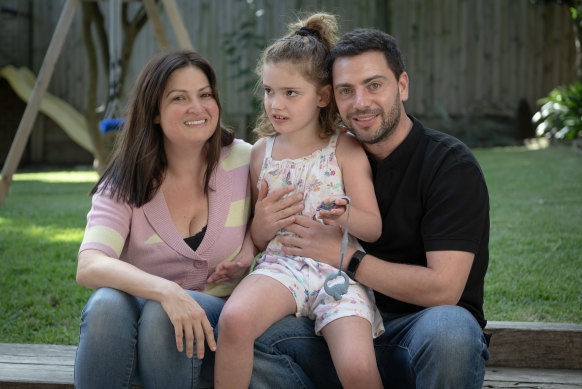Watching videos of their daughter’s birthday, David and Nadine Lipworth can’t recognise the girl sitting on her father’s lap, singing happy birthday as she blows out four candles.
Just months later, the mysterious genetic condition that had hampered Sasha’s development began whittling away at the small progress she’d made since birth. It robbed her of the ability to talk, play and complete basic tasks.

Sasha Lipworth on the swing her parents David and Nadine use to calm her down.Credit: Wolter Peeters
The Lipworths celebrated her seventh birthday this month. She couldn’t blow out one candle.
“It’s unthinkable now that she was able to say those things and to do those things,” David Lipworth says. “As a parent, you’re just living day by day and, almost to survive, you have to block it out of your memory.”
Sydney researchers are beginning to piece together the molecular puzzle behind Sasha’s regression, in the hope of developing personalised treatments not only for her but for other children with rare and ultra-rare genetic conditions.
After months of painstaking molecular detective work, University of Sydney Professor Sandra Cooper and her RNA for Rare Disease team this month identified the specific mutation in Sasha’s SLC6A1 gene that causes her condition.
‘Not like CSI at all’
Clinical genetic testing found a suspicious variant in Sasha’s SLC6A1 gene, which was starving her of proteins that her brain needs.
But DNA sequencing can examine only about 2 per cent of the genome, so Cooper’s team was charged with finding answers in the RNA – the molecules that carry protein-making blueprints from the DNA to outside the nucleus where proteins are made.
This involved a process of elimination, sifting through billions of pairs of the letters ACGT (representing the four “base” nucleotides, the building blocks in a DNA molecule) to find the one change that was responsible for her condition.
“That change can just be a G to a C – one among three billion base pairs,” Cooper says. “Finding that is really hard. It’s not like [the TV series] CSI at all.”
The mutation isn’t a problem with Sasha’s DNA code itself, but the way that code is copied and spliced into the RNA.
‘If our research can help forge this pathway for these personalised therapies, that actually has the potential to impact a lot of people.’
University of Sydney cell biologist, Dr Fran Evesson
Any change to this blueprint upsets the delicate balance of proteins moving messages through the brain, causing seizures and other abnormal activity.
Only one other person in the world is known to share Sasha’s mutation.
A molecular diagnosis is the first step towards developing a personalised gene therapy that, in theory, could potentially correct this RNA splicing change so that it can deliver the right amount of protein to the right cell at the right time.
Advancements in our understanding of RNA therapies, supercharged by the development of COVID vaccines, has opened a new frontier in Australia and the world.
“There was a global clinical trial showing that if you give RNAs to people, it doesn’t hurt them,” Cooper says. “We feel this is the next quarter-century of research, and we’re starting it [here in Australia].”
Finding a treatment
As Cooper leads research into identifying possible splice-switching treatments that might correct the RNA instructions for SLC6A1, her colleague Dr Fran Evesson heads a laboratory team studying whether this treatment will have the knock-on effect of restoring the function of the SLC6A1 protein.

Nadine, Sasha and David Lipworth at their home in West Pymble on Sydney’s north shore.Credit: Wolter Peeters
The team is investigating a program that could deliver personalised therapies that in turn could be applied to other conditions that collectively affect thousands of people.
“The pathway to make these types of personalised therapies in Australia doesn’t exist yet,” Evesson says. “If our research can help forge this pathway for these personalised therapies, that actually has the potential to impact a lot of people.”
Cooper and Evesson are keen to stress they are at the very early stages of their research. Cooper says she has 10-15 years left of her career: “I’m wondering if I can get this done before I retire.”
The researchers say that, even though Sasha’s RNA change is a good candidate for splice-switching approaches, it may not work in practice. And even if they can prove it works in cells in the laboratory, the path from there to her body is fraught with clinical, scientific, regulatory and logistical obstacles.
It is also costly. In the United States, personalised gene therapies for children with ultra-rare genetic glitches have been bankrolled by the n-Lorem Foundation, a non-profit that receives donations and discounts from biotechnology companies.
Murdoch University Emeritus Professor Sue Fletcher, widely acclaimed for her work developing antisense therapies that “skip” over rare and disease-causing genetic errors, says a similar organisation in Australia would “mean the world” to families without a treatment or even a diagnosis.
“You need pioneers, you need people who will push the envelope,” Fletcher says. “There will never be a profit in developing a therapeutic for one child, but somebody with an ultra-rare disease has just the same rights to treatment as anybody with any other disease.”
Racing the clock
For the Lipworths, every day that goes by is another day Sasha is missing out on development.
This month, they secured a prescription for Ravicti, a medication designed to halt her regression by preventing the harmful buildup of proteins in the body. It costs up to $100,000 a year. The “saving Sasha from SLC6A1” crowdfund they set up has so far received more than $90,000.
They have quit their jobs, their lives revolving around providing full-time care to Sasha (the centrepiece of their home is a swing that helps regulate her sensory processing disorder and extreme insomnia).
But by seeking an answer for their daughter, they hope to contribute to a field of medicine with almost limitless potential.
“Our total mission is just to give her an opportunity at a future – but we also realise the implications of it,” David Lipworth says.
“Sasha has an opportunity to be a part of bringing this revolution in genetic medicine to the world.”
clarification
This story has been updated to say that only one other person in the world is known to share Sasha’s mutation; also that Sasha was unable to talk rather than walk.